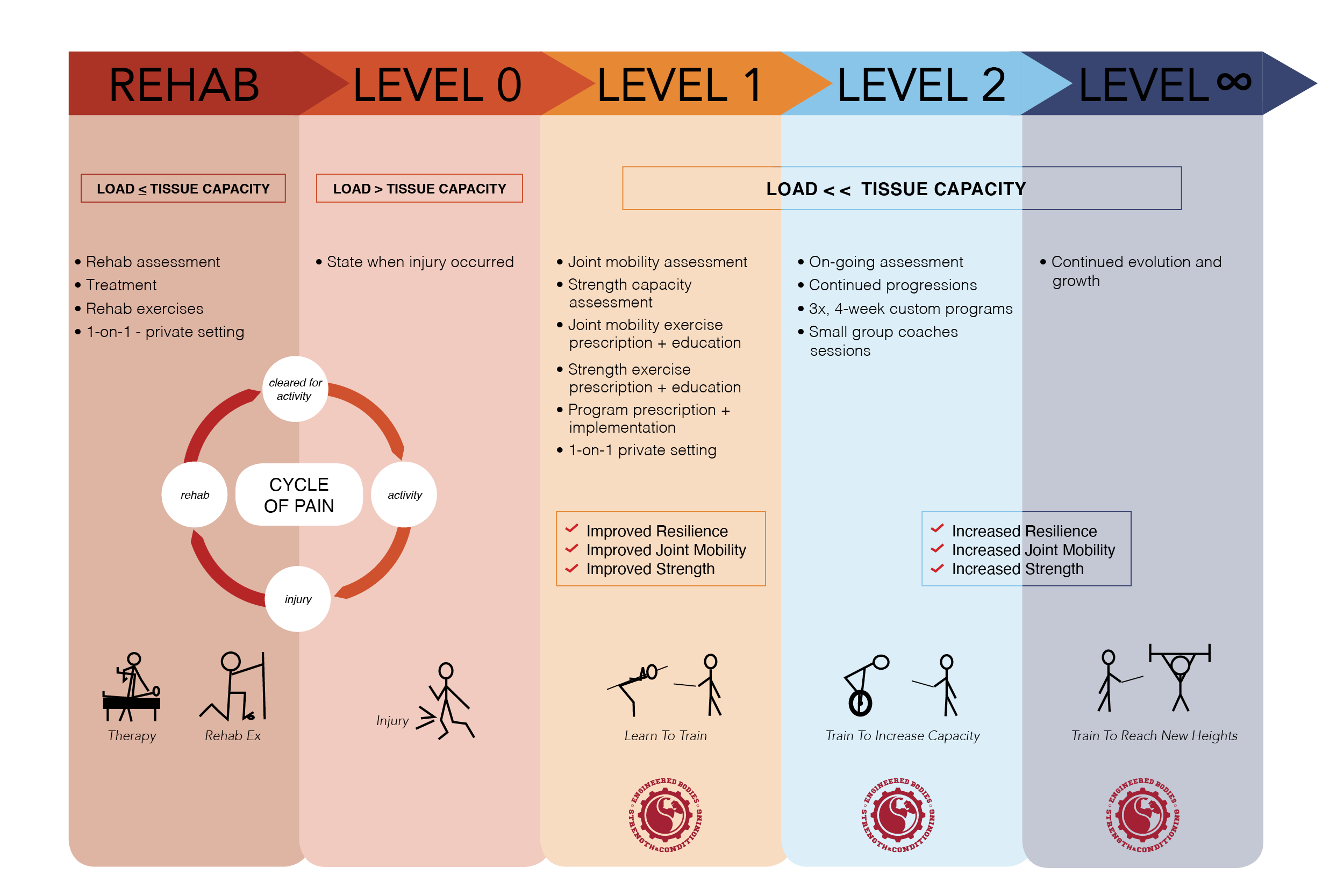The Injury, Rehab, and Training Continuum

Back in 2016, I wrote a blog post called “Training with an Injury” where I described three steps how you can continue to make gains without aggravating your injury.
STEP 1: GET YOUR INJURY PROPERLY DIAGNOSED BY A QUALIFIED CLINICAL PROFESSIONAL
STEP 2: DO YOUR MOVEMENT HOMEWORK!
STEP 3: CONTINUE TO TRAIN!
These steps are as valid then as they are now but what if you don’t train? What if you got injured and you’re a person who hates the gym and would rather continue life doing activities like yoga, hiking, running, skiing, or play your sport of choice?
If you’re a person who doesn’t train and you got injured during your activity of choice, you’ve likely gone through the following cycle of steps:
- Got injured
- Went to your doctor to get a diagnosis
- Went to your physiotherapist for treatment and received some rehabilitation exercises
- Did your rehabilitation exercises
- Possibly went to another therapist for additional treatment
- Continued with your rehabilitation exercises and other treatment for some time period
- Eventually got cleared by your physiotherapist to “return to sport or activity”
- Went back to that sport or activity
- Got injured
- Repeat steps 2-9 forever
If this sounds like YOU then you’re familiar with being stuck in what seems like an infinite loop of activity, injury, therapy, activity, injury, therapy. You are significantly more at risk to re-injuring yourself when you finally return to your chosen sport or activity after therapy.
The reason is simple. Treatment and rehabilitation exercises from therapy are designed to get your tissues back to the state that they were at the time of injury. Let’s call this state “LEVEL 0”. At LEVEL 0, your tissue’s capacity to withstand the load you subject your body to during your activity is less than those loads. When tissue capacity is less than those loads then injury occurs.
Load > Tissue Capacity = Injury
Your body’s tissues will adapt in response to force (loads). When you have an injury, the tissues must first heal the damage on itself and that process can only begin when it receives load. Doing nothing, does nothing. Too much load, too fast, will further damage the tissue so therapists prescribe rehabilitation exercises with significantly smaller loads than what you subject your tissues to during your regular activity.
This allows time for your tissues to eventually heal back to Level 0 at which time you are then typically cleared to “return to sport or activity”.
Rehabilitation exercise load << Tissue Capacity = Rehab to LEVEL 0
This is a problem when you return back to regular activity because your tissues were only rehabilitated back to LEVEL 0 and can still not handle loads from your activity. It’s only a matter of time before you re-injure yourself again and the cycle repeats itself.
The only way for you to avoid this endless cycle is to LEVEL-UP and increase the capacity of your tissues to handle higher loads. This is where strength training comes into the continuum of an individual’s evolution and growth. A well-designed and implemented strength training program will safely increase your body’s capacity to handle loads and produce force. When you get stronger, you LEVEL-UP and mitigate your risk to injury during your activity. Getting stronger also gives you the benefit of being able to perform at a higher level than you did at Level 0. Who doesn’t want that?!
Tissue Capacity >> Load = Strength training (LEVEL-UP)
If you don’t incorporate strength training in your life then you can never evolve past LEVEL 0 and you’ll be stuck in the infinite loop of activity, injury, therapy, activity, injury, therapy.
Hire an experienced and knowledgeable strength coach or personal trainer that can teach you you the basics, coach you on your technique, program for you, and assist you as you begin your LEVEL-UP journey. A great coach or trainer can be your biggest asset as they help you LEVEL-UP and prepare you for your current choice of activities or any new activities you decide to try in the future.
Don’t know what to look for when hiring a coach or personal trainer? This other blog post I wrote on the “Top 5 things to consider when hiring a personal trainer” will help you.

